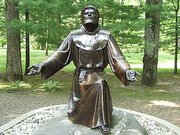The place of the possible

For instance, if Peter and Paul were together in Rome for a period of time, it is perfectly possible that, at some stage, they said goodbye to each other. It is equally possible that they were escorted by at least one of their early companions. It is equally possible, because it’s the way in which our minds function, that the early Church remembered the exact spot at which the two men parted and also that it was the last time that they were together before their capture and execution. It is, therefore, not impossible that, when it was safe to do so, a small memorial of that event was put in place to remind people, including those of future generations, that ‘this place is special, and here’s why’.
That is why, walking home one evening whilst I was still in Rome, and thinking of nothing in particular, I was brought to a sudden halt. The stone plaque on the wall, too distant to be seen clearly from the bus, even in a traffic jam, commemorated that very goodbye! Apparently there had originally even been a small church on the same site, long since replaced by modern and extremely ugly industrial buildings. Yet, in that small plaque, Peter and Paul embraced each other for the last time, on the very spot at which their paths diverged.
What was it like? Did they know that they wouldn’t see each other again? Were they scared, even though they knew that they were walking in the same steps as Jesus of Nazareth? Did Paul know that he was almost exactly, to the very yard, at the mid-point of two of his future significant locations? One was the start of his chained journey to the Via Appia and subsequent execution at the spot now known as Tre Fontane. The other was his burial site, then the ordinary cemetery on the Via Ostiense and now marked by the magnificent basilica of St. Paul’s outside-the-walls.
When Peter and Paul said goodbye to each other, which road did they take? Did Peter travel along the Via Ostiense towards Ostia and the Christian community in that thriving seaside port, or did he take some other route?
Did Paul retrace his steps back into the city, along the Via Mamorata and Lungotevere, bypassing the Forum and the Coliseum? Presumably he passed through the city gate, now known as the Porta San Paolo because of its associations with him. What were his thoughts as he walked? He must have known that the tide was turning ever more strongly against him and the early followers of his Lord. He knew that, sooner or later, his persistence in preaching the Gospel would create enemies strong enough to demand his execution. As a Roman citizen, he could be beheaded and so wouldn’t suffer the appalling agony and indignity of crucifixion, but was he scared? His faith would see him through to the end, but did he wonder whether or not the axe would hurt him, or whether death would be instantaneous?
As Paul walked past the Mamertime prison, did he remember his time (according to tradition) with Peter, incarcerated in its cold darkness, a cold so penetrating that, in one of his letters, he asked Timothy to collect his cloak and bring it along for him to use? He wouldn’t have foreseen the huge numbers of tourists who would, in subsequent centuries, visit his cell and try to visualise themselves in his place. He wouldn’t have known that, within a relatively short time, Peter, Simon, Jude, Barnabas, Philip, James and Matthias would also be buried in Rome and that pilgrims would visit the tombs in gratitude for the legacy left by the Apostles.
Rome. The place of the possible. Is it possible that, whilst filled with hope and confidence in his Risen Lord, Paul was also afraid of his own Calvary? Wouldn’t that have been very human? Doesn’t this make our own anxieties for the future a very normal part of life?
Sr. Janet

